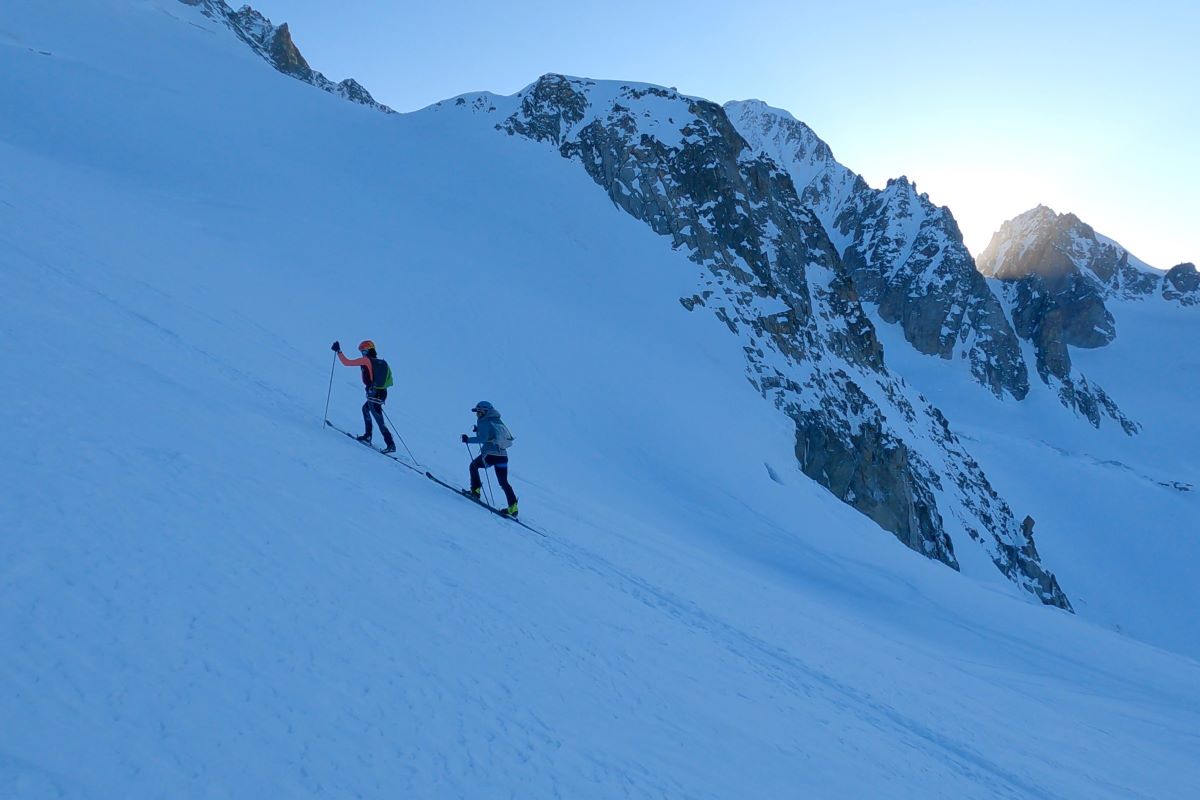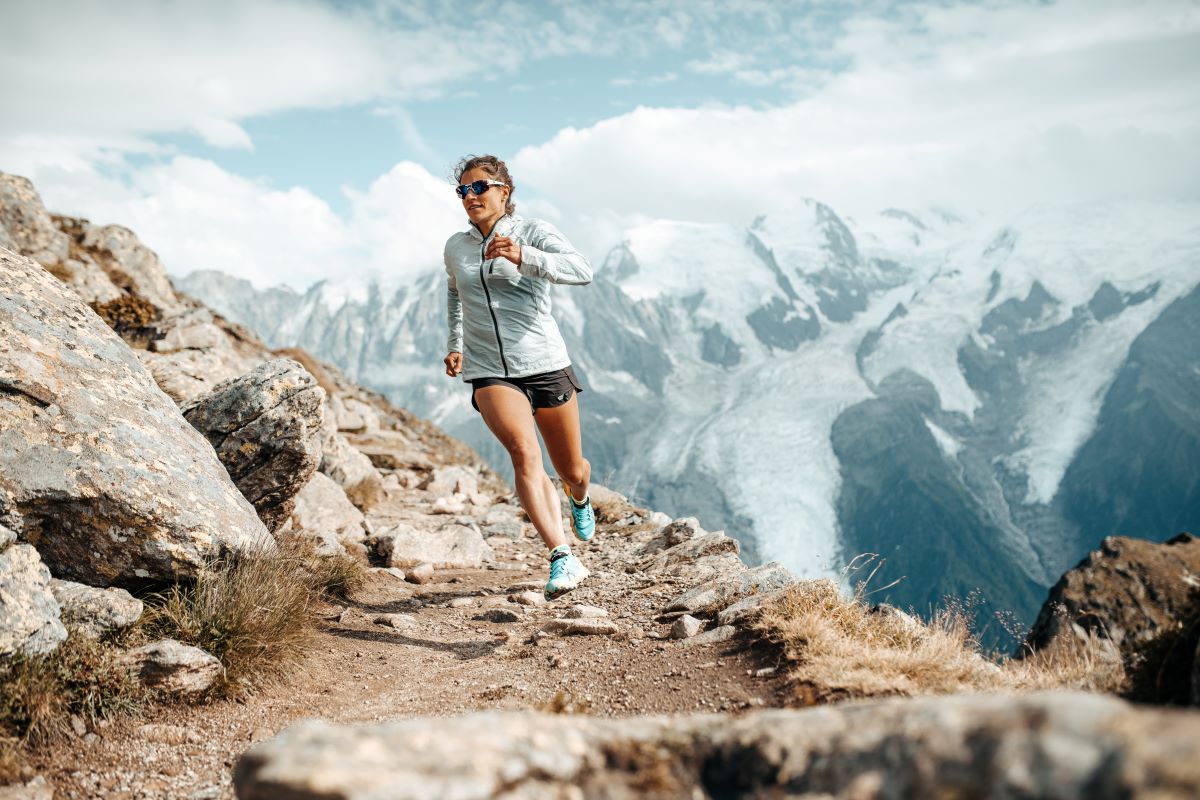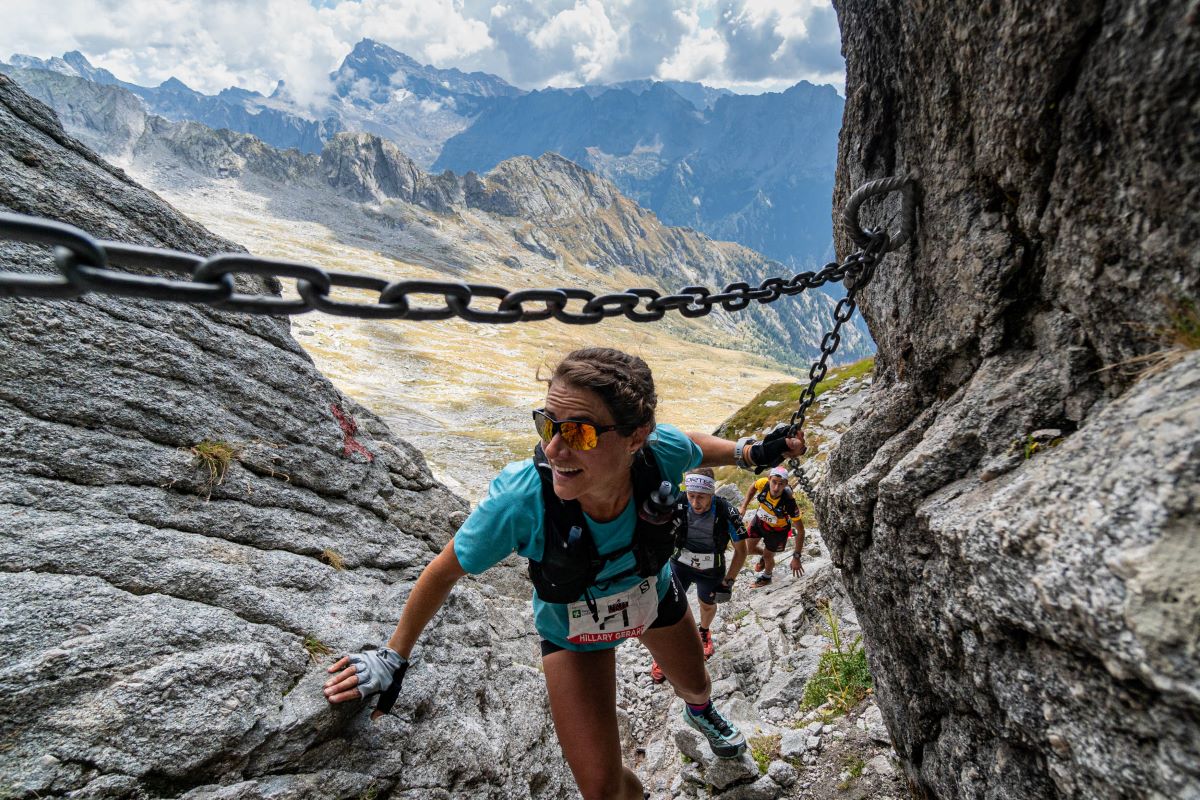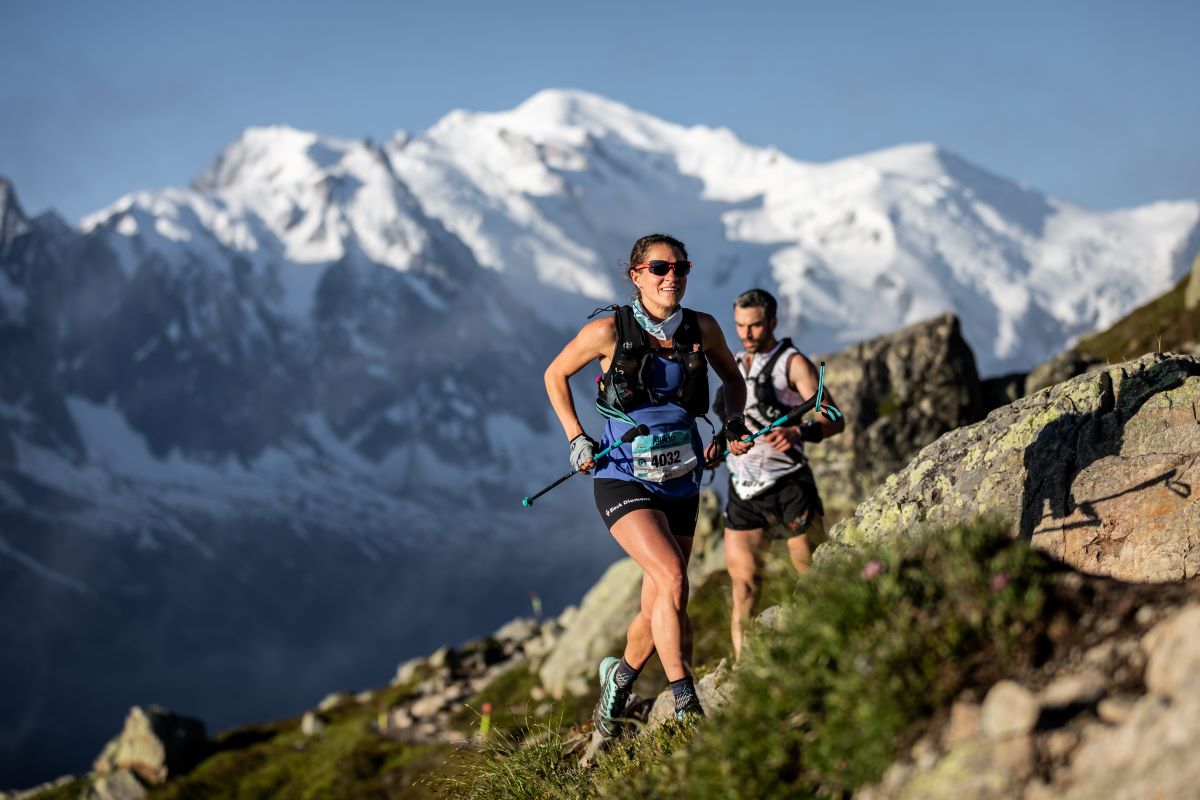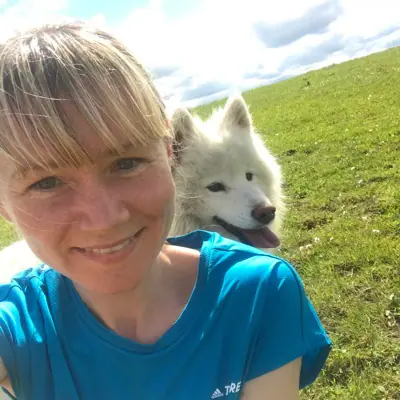Hillary Gerardi has been a household name in mountain sports for a good many years.
A highly adaptable athlete, she has excelled at ultramarathon distances, winning the 120-kilometer Grand Raid des Pyrénées in 2015, while still very new to trail running, and more recently the 2021 Marathon du Mont Blanc 90k, as well as at shorter-distance skyraces and vertical-kilometer races.
Last year, alongside friend and world champion ski mountaineer Dr. Valentine Fabre, she set the first women’s ski speed record on the Haute Route from Chamonix, France, to Zermatt, Switzerland. The route covers 66 miles of snow and glaciers with 26,000 feet of elevation gain, and the pair completed the traverse in 26 hours and 21 minutes.
The life lessons provided by a long career in sport have taught the Chamonix-based American to be focused and unwavering in her goals. This August, when UTMB fever was in full swing in her hometown, Gerardi’s thoughts were fixed on a different prize — the highly technical 52k Trofeo Kima skyrace in Italy. On August 28, she won the race in 7:30:38, toppling Núria Picas’s 10-year-old course record of 7:36:21.
I caught up with her to find out more about Trofeo Kima and what it means to her, to pick her brain on how to train for high-level technical mountain races, and to learn a little more about the woman behind these mountain achievements.
Hillary Gerardi grew up in Vermont and attended university at Middlebury College. While at university, she worked in mountain huts, operated by the Appalachian Mountain Club in the White Mountains of New Hampshire. This was her first introduction to life in the mountains.
She had a love of maps, and would pore over her maps and plan routes through the mountains, even if it was just to sneak over to another hut to play a prank on her friends there. Along with likeminded friends, she took on a number of short expeditions and challenges in the mountains:
“There were a lot of endurance-type challenges, with strict goalposts around them, in that we’d have a day. After breakfast and before dinner, we could head out and do stuff, but we had to be back for breakfast and dinner. Speed was actually required in that sense.
“There was a challenge called the [White Mountains] Hut Traverse. You go hut to hut across the eight White Mountains huts. It’s a little over 50 miles with 30,000 feet of elevation. And that was the big challenge when we worked in the huts. But I never considered myself a runner when I did that. The challenge was to do it in less than 24 hours, but we were hiking, we weren’t running.”

A young Hillary Gerardi (right) with Mayaan Cohen at Madison Hut in the White Mountains of New Hampshire where they both worked. Photo: Alexander MacPhail
After finishing college, Gerardi’s then-boyfriend, now husband, Brad Carlson secured a teaching position in Grenoble, France. Carlson now works as a mountain guide and the couple shares a love of the mountains, so it didn’t take much convincing for Gerardi to embark on a new adventure in the French Alps.
She also found her niche professionally in their new home, and said, “I studied sociology and anthropology, so not environmental related. But just from living and working in the mountains, I was always fascinated with the outdoors.”
While in France, she pursued a master’s degree in International Cooperation and Multilingual Communication, which led her to work in the Research Centre for Alpine Eco-Systems (CREA Mont-Blanc) in Chamonix, where she worked for almost six years until May of this year.
While living in Grenoble, where the couple spent six years before moving to Chamonix, Gerardi became immersed in mountain sports, particularly skiing. But a bad fall left her wondering if there were other, somewhat safer, ways to play in the mountains. She said:
“Miraculously I didn’t get seriously injured, but it did leave me wondering if I needed a different way to be in the mountains. Something a little less dangerous, a little more fun, where I felt a little bit more in control. And my husband was like, ‘Well, remember you did trail running that one time? That went well, why don’t you do that again?’ I thought, Sure, I could do that!”
Although Gerardi’s career in mountain running didn’t truly start until after the move to France, she had done one trail race in the U.S. prior — the Great Adirondack Trail Run.
She continued, “He was super supportive. We signed up for a relay race that year where he did a 30k and I did a 50k and we had a lot of fun. But in training, a few weeks before that race, a friend of mine said, ‘I’m racing tomorrow, do you want to come?’”
Gerardi attended the small, village race with her friend, and to her surprise and delight took first place. “I won that race and won a six-kilogram leg of prosciutto, and was just so psyched about it. Getting home with this giant leg of ham, my husband was like, ‘This is awesome, I will support this, you can come home with ham every weekend!’”
She quickly discovered the abundant and welcoming trail running community that exists in Grenoble. “There’s a ton of races around. It’s a big city, over a half million people, and there’s a lot going on and there are a lot of young people.”
Gerardi was quickly drawn to ultra distances. In 2015, she raced the 73k Tour des Glaciers de la Vanoise and the 120k Grand Raid des Pyrénées, taking second and first place, respectively. But she was still motivated more by the love of the mountains and the personal challenge than by the results, and said of her win at the Grand Raid des Pyrénées, “It was more like a challenge, to see can I run 120k.”
For 2016, she had set her sights on the 140k L’echappée Belle, a gnarly ultra in the Belledonne massif, near Grenoble. Unfortunately, over the course of her training, she had a fall while cycling, breaking a number of ribs and altering her plans for the year. No longer able to sustain high-volume ultramarathon training while recovering from her injuries, with the help of a friend who was studying coaching, Gerardi reset her goals and turned her attention to a shorter race.
“We did La Skyrhune, which was a skyrunning race. I had a wonderful time, great ambience, there was this fantastic party afterward, and I just thought skyrunning was so cool! You can finish your race, really give it everything you’ve got, say if it’s 25k or something, and a few hours later you can still get up and do other things!” Discovering skyrunning opened up a world of new adventures to Gerardi and her growing tribe. She said:
“That was the year that I met Katie Schide. And I told her, ‘This skyrunning is so fun, we should go to Limone Extreme!’ I had just Googled it. She was living in Switzerland, and I was in Italy, and we were like, ‘Let’s just meet at this race!’ It was the final of the Skyrunner World Series and neither of us knew enough to be intimidated at all. There were all these top international runners there and we just had no clue. But we went and we had loads of fun, and we both finished top 10. I was eighth and she was 10th.”
Following on from this, Gerardi decided to complete the Skyrunner World Series in 2017, with the goal for the year being to complete the series and attain an international ranking.
“I think that I ended up fourth in the series that year, which really exceeded my expectations.”
The Skyrunner World Series was then categorized into Classic, Ultra, and Extreme. In 2017, Gerardi focused on the Classic division but said, “By 2018, they had a combined Ultra and Extreme into one category. Going into 2018, my big goal was to do the Extreme Ultra races, which were the Tromsø Skyrace, Trofeo Kima, and Glen Coe Skyline. That was what I was really aiming for that year, because the really technical stuff was what I liked.”
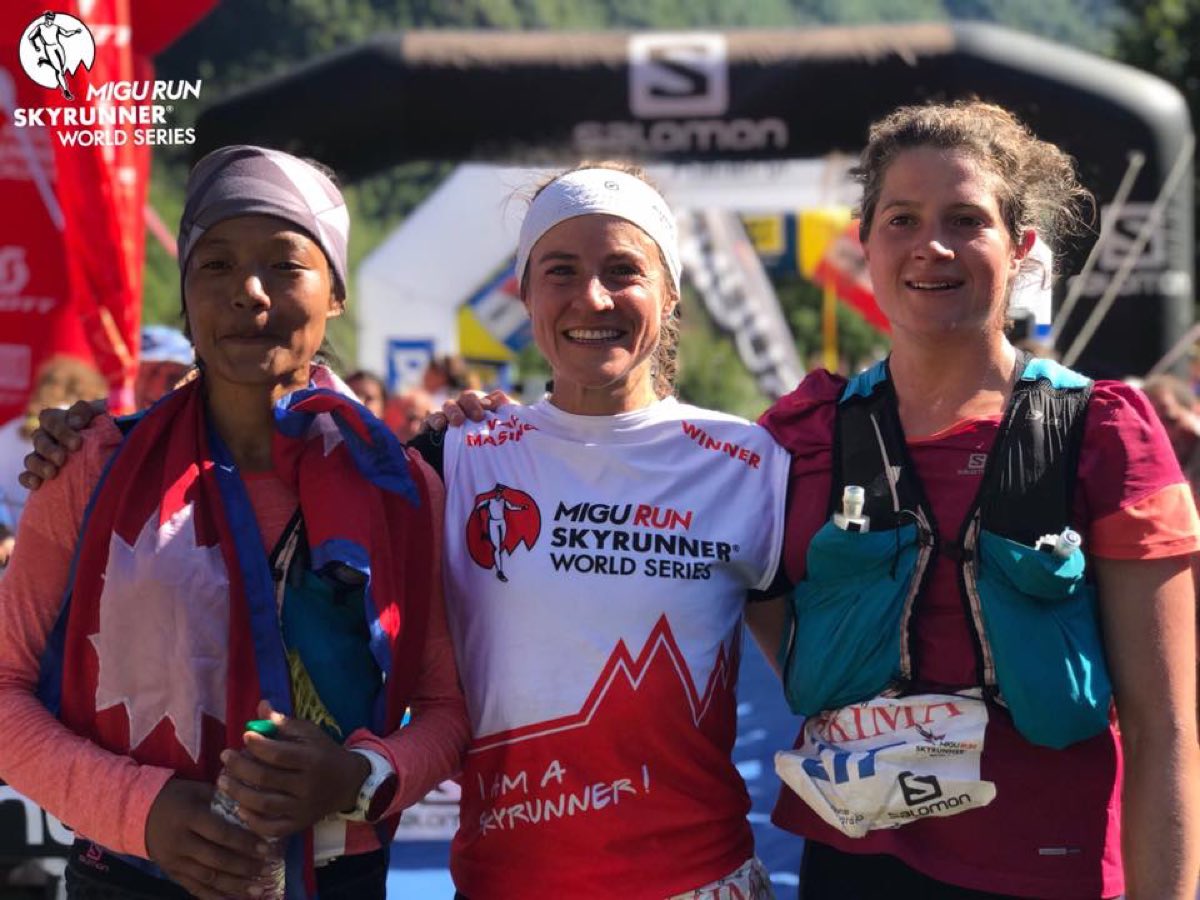
The 2018 Trofeo Kima women’s podium (l-to-r): 3. Mira Rai, 1. Hillary Gerardi, and 2. Robyn Owen. Photo: Skyrunner World Series
She won all three of her goal races that year, but made a decision she would later regret, to line up for the end-of-season Limone Extreme skyrace, which hadn’t been part of her original plan. One more race proved too much at the end of an already exhausting season. She said:
“I was in second place for the overall ranking, I had won the Extreme Ultra category, so everyone was like, ‘Well Hillary, you have to go to Limone, you have to do this other race.’ I got pretty caught up in feeling unbeatable and so I went into that race, with honestly unreasonable expectations, given that I was exhausted from the season, and I hadn’t ever set that as an objective. I ended up DNFing, which was my first-ever DNF and I was completely gutted.”
Although a tough lesson, this was a turning point for Gerardi, who said, “I realized at that point, and this has influenced how I set goals now, that I had let other people decide what success was going to look like for me for that season. I knew what I wanted from the beginning, to do the longer races, and they went well. But I let my goal become a bit clouded and added this new thing.” Four years on, this lesson has stood her in good stead:
“My goal this year was Trofeo Kima. It’s interesting because Kima happens the same weekend as UTMB. I live in the Chamonix Valley, and everyone comes here to do UTMB, and to get ready for UTMB, and everyone talks about UTMB for the weeks leading up to it. So, people know I’m a runner and they’re all like, ‘Are you doing UTMB?’
“They’re kind of confused when I say no. But I think I’ve matured as an athlete and I know what kind of racing I like to do, what really motivates me. The fact that everyone is at UTMB is not enough for me to change my own goals to line up to everybody else’s expectations. I know what I want.”
Trofeo Kima traditionally takes place once every two years, but as the 2020 running was canceled due to the COVID-19 pandemic, this year was the first time the event had been held in four years. Gerardi described the race, which is “fifty-two kilometers with 4,200 meters of vert and super technical. It goes over seven mountain passes above 2,400 meters, passes a bunch of Alpine huts, and it’s absolutely beautiful.”
She added, “This year, I wouldn’t say I had singular focus on it, there were a few other races, but it was really the big objective.”
Gerardi won the last Trofeo Kima, back in 2018. But without being aware of it until afterward, she also finished just a minute and eight seconds over Núria Picas’s 2012 course record, making it impossible to not come back for another go.
She said, “It was super cool, like I would not have been able to [beat Picas’s record] that year, I put everything I had into it. And so, I knew this year that my goal was to better my own racing, and so that could mean that I could take the record.”
This was just how it transpired, in taking seven minutes off her own previous time and a second consecutive win, Gerardi also left with the course record.
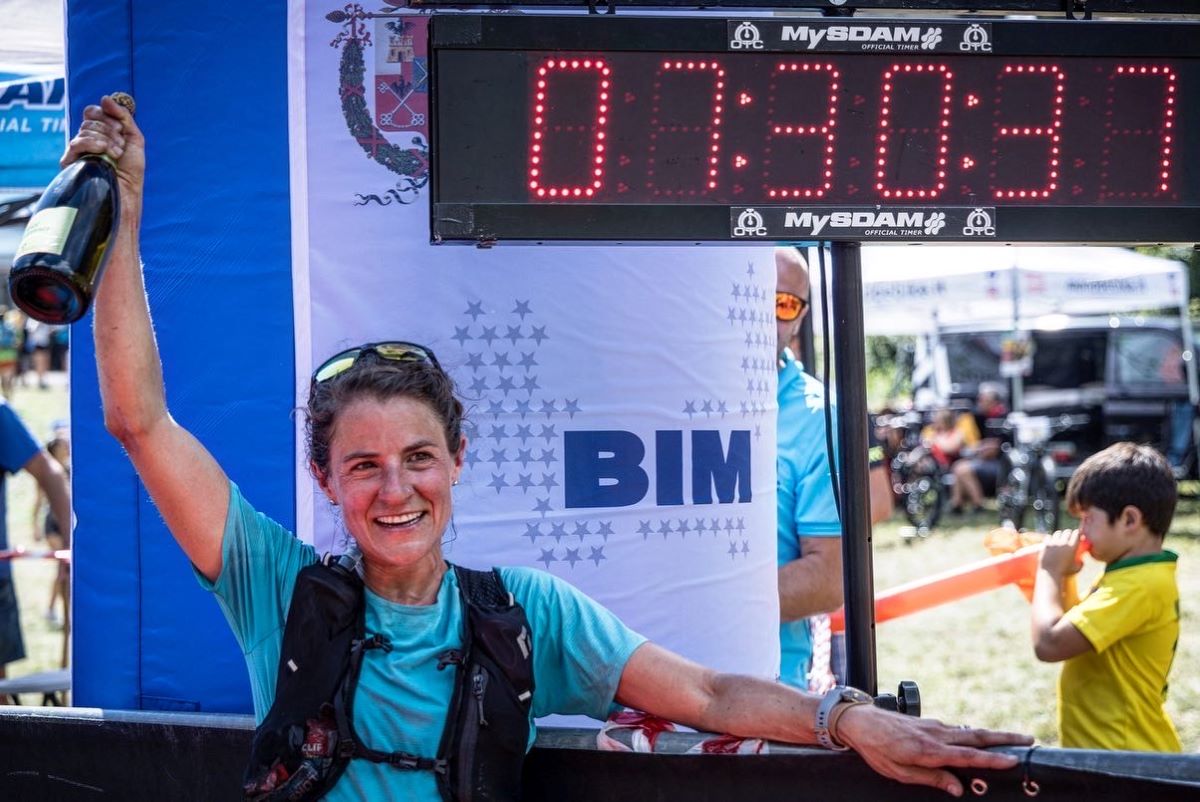
Hillary Gerardi celebrates winning the 2022 Trofeo Kima, and setting a new course record. Photo courtesy of Hillary Gerardi.
Looking back on her years in the sport, Gerardi reflected on the evolution of the competition in technical mountain races, saying, “Back in 2018, I felt like I was in the upper percentile in terms of technical ability without really working on it, but now I think there are more and more women who are really strong athletes but also really strong technically, which is so cool to see.”
This evolution has altered the way she prepares for her races, and she now trains more mindfully and specifically for technical races.
She said, “One of the things I think about is the mental energy that comes with picking a line. Like if you’re going across a boulder field or running in the fells, for example, where there isn’t a really evident trail. You have to kind of pick what line you’re going to be running. I find that early in the season, my brain gets tired and my eyes get tired. So one thing I tried to do early this season was to build my mental endurance for that, to work on route finding.”
She added, “I work on a lot of powerhiking; I even do powerhiking intervals where the running is the rest.”
Having finished her full-time position with CREA Mont-Blanc, Gerardi remains interested in the intersection between sport and climate action and said, “I’m involved with a couple of nonprofits, and we’re currently working with Dakota Jones’s Footprints Running Camp and looking at setting one up in Europe.” As well as this, she is also pursuing initiatives to increase diversity and inclusion in sport.
In terms of running goals for the next season, Gerardi said she is letting this one sink in first before she focuses her mind on the next target. But one thing is for sure — once she has picked a line, there will be no steering her off of it.
Call for Comments
- Have you seen Hillary Gerardi in action?
- Have you done any of the technical races mentioned in this article?
